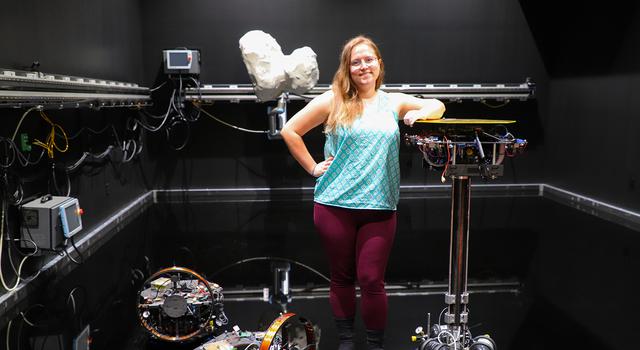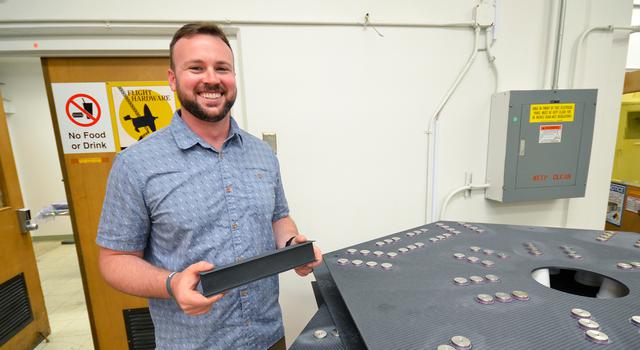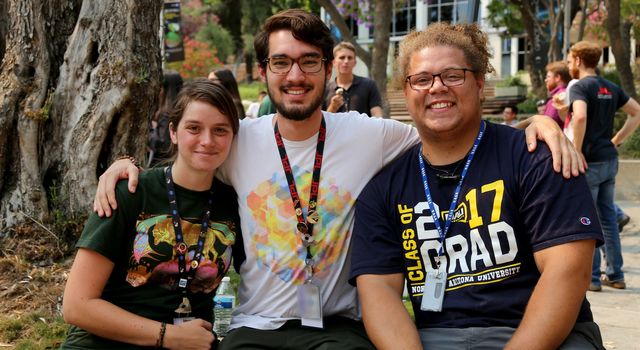Meet JPL Interns| August 28, 2018
An All-Inclusive Intern Experience at NASA/JPL
When the new crop of summer interns started showing up at NASA’s Jet Propulsion Laboratory in Pasadena, California, this past June, they joined the more than 2,000-plus students placed across NASA’s 10 field centers, instantly becoming part of the NASA family.
“They may not be together geographically, but these interns are getting this unique experience all over the country,” said Katherine Brown, public affairs officer for education at NASA Headquarters.

Meet JPL Interns
Read stories from interns pushing the boundaries of space exploration and science at the leading center for robotic exploration of the solar system.
But between the challenging workloads, exciting education opportunities and inspiring culture at JPL, interns who come to the laboratory often see only one piece of the NASA puzzle. Intern and University of Colorado Boulder astrophysics student Maya Yanez has spent the past two summers at JPL – one working on describing potential radical chemistry on Kuiper Belt objects, and one helping to identify potential landing sites on Jupiter’s moon Europa.
“You get the chance to be a little sprocket in this massive machine of making things happen at JPL, but then you can kind of lose sight of the fact that JPL is one component of NASA, and there are hundreds of interns at other centers doing comparable things,” Yanez said.
This year, NASA Headquarters’ internship and communications coordinator Christine Linsinbigler saw opportunities to bring the centers together. She organized an agency-wide live feed of NASA Administrator Jim Bridenstine’s intern town hall at Goddard Space Flight Center on July 26, and an ISS downlink Q&A – where interns got to pre-record questions for astronauts to answer live from the space station – on July 30.
“With National Intern Day on July 26, we were able to roll the events into one big intern week,” Linsinbigler said.
Answers from the Administrator
This was the first year a NASA administrator conducted a NASA-wide town hall, where interns from all of the centers could submit questions in short videos. Yanez was selected to live-tweet Bridenstine’s responses from the JPL Education Office’s @NASAJPL_Edu handle so students, JPLers and members of the public could see some of the responses.
“The administrators’ town hall was really important because, for the first time, I had an opportunity as an undergrad to ask about our future and the future of space funding,” said Yanez, who also hopes to one day run for office. “This is a person who has power over our future. I think it’s important to keep that communication between science and politics.”

Yanez hosted a takeover of the @NASAJPL_Edu Twitter account during the NASA Internships Town Hall with Administrator Jim Bridenstine. Credit: NASA/JPL-Caltech/Kim Orr | + Expand image
Yanez was also appreciative of the administrator’s openness to discuss inclusion and diversity in the field, and how NASA plans to maintain its current programs.
“I’m half Mexican, a female in STEM, a first-generation college student, and low income, so I check off a lot of those representative boxes,” Yanez said. “It was nice that he spent as much time on that question as he did. He talked about how it mattered to him and how it should matter to all of us.”
At NASA Headquarters, inclusion and diversity within NASA starts with the intern program, which saw its largest and most diverse applicant pool of interns this summer. Brown said it followed a concerted effort of making the public aware that an internship at JPL, Langley or Johnson is more than just for STEM students – there are opportunities in communications, human resources, education and other fields that are all relevant to how the agency runs.
“We’ve showcased interns on our social media, we held a Reddit ‘Ask Me Anything’ Q&A with Johnson Space Center Flight Director Allison Bollinger, and we’re hoping that including more events like the administrator town hall and ISS downlink will continue to attract a diverse group to NASA,” Brown said.
Questions to Space
When JPL intern Zachary Luppen heard about the ISS downlink – and that he would have a chance to ask an astronaut a question – he already had pages of questions lined up.

A watch party was held at JPL for an ISS downlink with NASA astronaut Ricky Arnold. Image credit: NASA/JPL-Caltech/Lyle Tavernier | + Expand image

Zachary Luppen stands in an anechoic chamber at JPL. Image credit: NASA/JPL-Caltech/Kim Orr | + Expand image

Christopher Jia-Kuan Yen poses with his mentor, Abigail Fraeman, during a mentor appreciation event held at JPL. Image credit: NASA/JPL-Caltech/Lyle Tavernier | + Expand image
“I had always wanted to ask an astronaut something, but I didn’t know how to go about doing it,” said Luppen, who is entering his senior year as an astronomy physics major at the University of Iowa. “I really want to go into space, and here I suddenly have this opportunity to throw a question at an astronaut and get it answered.”
The pre-recorded video questions from interns across NASA centers were played during the ISS downlink on July 30, and JPL interns gathered to hear astronaut Ricky Arnold’s responses. Luppen asked Arnold if there were any specific pointers he could give NASA interns who want to be astronauts themselves, and go to the ISS, the Moon or even Mars.
“The temptation is to specialize early, and it’s great to find your passion and pursue it, but don’t lose sight of the bigger picture,” Arnold said. “NASA is looking for people with very diverse backgrounds, who have done a lot of different things in different environments with different people.”
Luppen said the ISS downlink was special, as it was one of many “bucket list” items he was able to check off during his summer at JPL, but the work he conducted at the laboratory was more important to his future. Over his 10 weeks at JPL, Luppen worked on test procedures for the dual-frequency radar instrument (REASON) slated to ride aboard NASA’s Europa Clipper spacecraft. That allowed him to connect with a group of employees who are really doing what he wants to do.
“At Iowa, we’re building parts of the Europa [Clipper mission] there too, but we’re not working on spacecraft to the degree that JPL is,” Luppen said. “I’m here with like-minded people, fantastic scientists and engineers who are working on these projects, and it’s just great to finally be at a center where it’s so productive. It’s almost like chaos, but it’s so cool. I mean, how many missions did we have launch this summer? So, it’s just like, we’re so busy, and I’m getting to be a part of it this summer.”
Intern Christopher Jia-Kuan Yen, a senior geology-chemistry student at Brown University, spent his summer working with Deputy Project Scientist Abigail Fraeman on remote sensing and imaging instruments aboard the Mars Reconnaissance Orbiter. As for the question he asked of astronaut Ricky Arnold, it was – of course – imagery based.
“I wanted to know, based on what he’s seen from the windows of the ISS, where he would most like to visit on Earth,” Yen said.
Arnold responded that the list seems to get longer every day he’s on the station, but the mountains of Peru, Chile and Argentina have caught his eye. “I guess I’ll have to head down there and check it out someday,” Yen said with a smile. In retrospect, Yen viewed the ISS Downlink as one more example of how special interning at JPL can be.
“There are just so many things going on here,” he said. “Between the work you’re doing, the lectures – I mean, we had the Mars helicopter team present to us – and the events like the ISS Downlink, I don’t think you’re getting opportunities like those at your university internship.”
This summer, 400 JPL employees participated as mentors, providing guidance to the 700 interns working in various fields across the laboratory.
To learn more about this year’s interns, visit:
Explore JPL’s summer and year-round internship programs and apply at: https://www.jpl.nasa.gov/edu/intern
The laboratory’s STEM internship and fellowship programs are managed by the JPL Education Office. Extending the NASA Office of Education’s reach, JPL Education seeks to create the next generation of scientists, engineers, technologists and space explorers by supporting educators and bringing the excitement of NASA missions and science to learners of all ages.
TAGS: Interns, Internships, Student Programs, STEM, STEM Education, College Students










